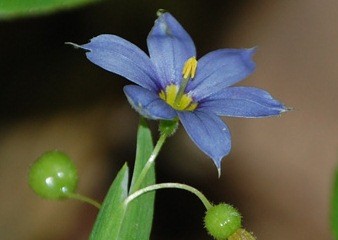Narrow-leaf blue-eyed-grass
(Sisyrinchium arenarium arenarium)

Description
Sisyrinchium angustifolium, commonly known as narrow-leaf blue-eyed-grass, is a herbaceous perennial growing from rhizomes, native to moist meadow and open woodland. It is the most common blue-eyed grass of the eastern United States, and is also cultivated as an ornamental. Range: Eastern Canada and US, west to Texas and Minnesota, in meadows, low woods, and shorelines. Height: 15–50 cm (6–20 in). Stem: broadly winged, 2–4 mm (1⁄16–3⁄16 in) wide, usually branched. Leaves: 2–6 mm (1⁄16–1⁄4 in) wide. Tepals: 6, blue, 7–10 mm (1⁄4–3⁄8 in), each tipped with a sharp point, veined, and darkening toward central yellow patch. Sisyrinchium is a large genus of annual to perennial flowering plant in the family Iridaceae. Native to the New World, the species are known as blue-eyed grasses and, though not true grasses and in varieties with flower colors other than blue, are monocots. Several species in the eastern United States are threatened or endangered. These are not true grasses, but many species have the general appearance of grasses, as they are low-growing plants with long, thin leaves. They often grow on grasslands. Many species resemble irises, to which they are more closely related. Most species grow as perennial plants, from a rhizome, though some are short-lived (e.g. S. striatum), and some are annuals (e.g. S. iridifolium). The flowers are relatively simple and often grow in clusters. Many species, particularly the South American ones, are not blue, despite the common name. The genus includes species with blue, white, yellow, and purple petals, often with a contrasting centre. Of the species in the United States, the Western Blue-eyed Grass, Sisyrinchium bellum, is sometimes found with white flowers, while the California Golden-eyed Grass, Sisyrinchium californicum, has yellow flowers. The genus was named by Carl Linnaeus in 1753, based on the species Sisyrinchium bermudiana (commonly called Bermudiana). Sisyrinchíon is the Greek word, recorded by Pliny and Theophrastus, for the Barbary nut iris (Iris or Moraea sisyrinchium), and refers to the way the corm tunics resemble a shaggy goat's-hair coat, sisýra. Authors as early as 1666 give the dubious etymology of Latin sūs "pig" and Greek rhynchos "nose", referring to pigs grubbing the roots. As Goldblatt and Manning explain, "the reason for applying the name to a genus of New World Iridaceae was apparently arbitrary."
Taxonomic tree:







